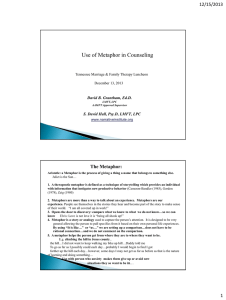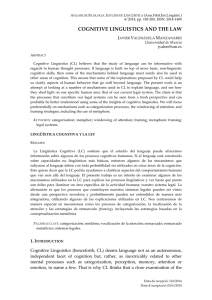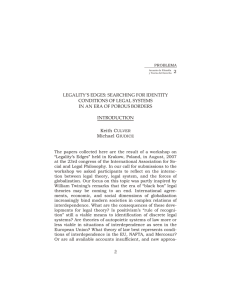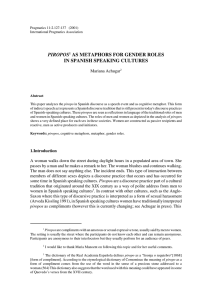Analysing Metaphors in Commercial Advertising
Anuncio
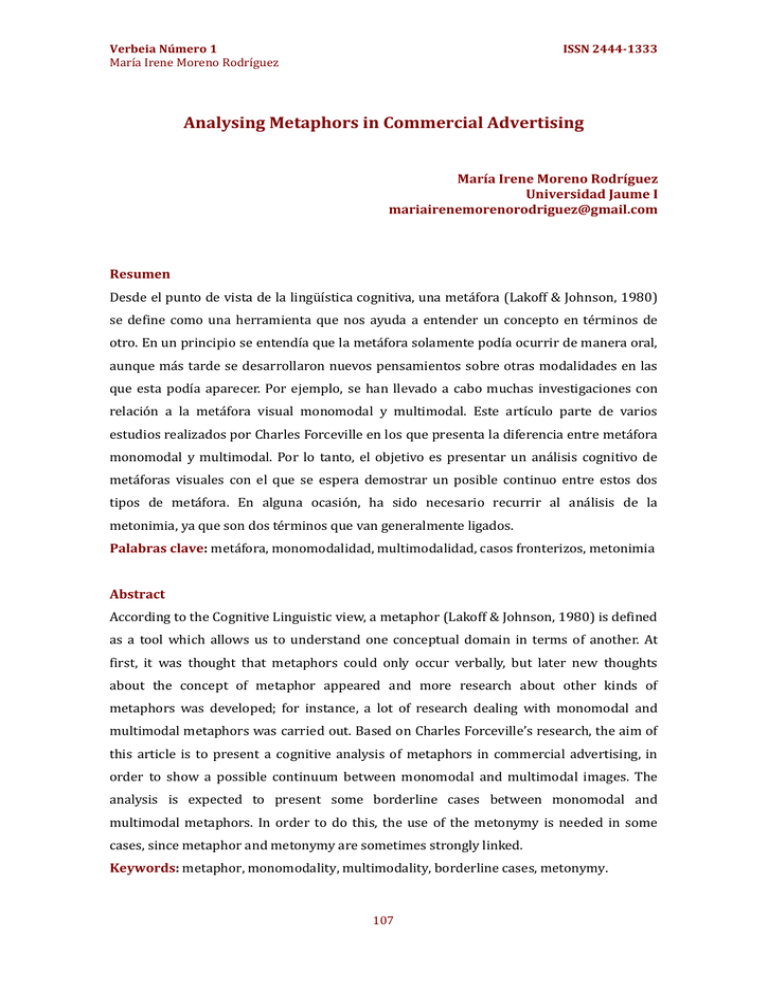
Verbeia Número 1 María Irene Moreno Rodríguez ISSN 2444-1333 Analysing Metaphors in Commercial Advertising María Irene Moreno Rodríguez Universidad Jaume I mariairenemorenorodriguez@gmail.com Resumen Desde el punto de vista de la lingüística cognitiva, una metáfora (Lakoff & Johnson, 1980) se define como una herramienta que nos ayuda a entender un concepto en términos de otro. En un principio se entendía que la metáfora solamente podía ocurrir de manera oral, aunque más tarde se desarrollaron nuevos pensamientos sobre otras modalidades en las que esta podía aparecer. Por ejemplo, se han llevado a cabo muchas investigaciones con relación a la metáfora visual monomodal y multimodal. Este artículo parte de varios estudios realizados por Charles Forceville en los que presenta la diferencia entre metáfora monomodal y multimodal. Por lo tanto, el objetivo es presentar un análisis cognitivo de metáforas visuales con el que se espera demostrar un posible continuo entre estos dos tipos de metáfora. En alguna ocasión, ha sido necesario recurrir al análisis de la metonimia, ya que son dos términos que van generalmente ligados. Palabras clave: metáfora, monomodalidad, multimodalidad, casos fronterizos, metonimia Abstract According to the Cognitive Linguistic view, a metaphor (Lakoff & Johnson, 1980) is defined as a tool which allows us to understand one conceptual domain in terms of another. At first, it was thought that metaphors could only occur verbally, but later new thoughts about the concept of metaphor appeared and more research about other kinds of metaphors was developed; for instance, a lot of research dealing with monomodal and multimodal metaphors was carried out. Based on Charles Forceville’s research, the aim of this article is to present a cognitive analysis of metaphors in commercial advertising, in order to show a possible continuum between monomodal and multimodal images. The analysis is expected to present some borderline cases between monomodal and multimodal metaphors. In order to do this, the use of the metonymy is needed in some cases, since metaphor and metonymy are sometimes strongly linked. Keywords: metaphor, monomodality, multimodality, borderline cases, metonymy. 107 Verbeia Número 1 María Irene Moreno Rodríguez 1. ISSN 2444-1333 INTRODUCTION The following piece of work is framed within the area of cognitive linguistics. Cognitive linguistics explores “the relationship between human language, the mind and sociophysical experience” (Evans et al., 2007: 2). One of the aspects, which researchers have stressed the most, is the analysis of how linguistic knowledge is linked to world knowledge, or, in other words, the relationship between language and world experience. Nowadays, there are many theories about this relationship, and various contradictions exist among them. Specifically, the study of metaphor and its cognitive motivation is one of the biggest challenges cognitive linguistics has faced. 1.1. Conceptual Metaphor In the cognitive linguistic view, a conceptual metaphor (Lakoff & Johnson, 1980) is defined as a tool which allows us to understand one conceptual domain in terms of another. Cognitive metaphors help us to understand complex and abstract concepts in terms of simpler ones (Lakoff & Johnson, 1980; Forceville, 2006). This process involves mappings between two domains in our mind. In Cognitive Linguistics, a mapping is defined as a set of correspondences between conceptual domains (Lakoff & Johnson, 1980). According to Johnson (1987), in order to further comprehend their life experience, people organize and link concepts. What usually happens is that we use a physical or a simple concept we already understand in order to comprehend something abstract or more complex. That physical or simple concept is called the source domain, and the abstract concept, or what we need to comprehend, is the target domain. There are two main factors that play an important role when dealing with metaphors. One is the socio-cultural factor (Gibbs & Cameron, 2008) and the other factor is more cognitive (Steen, 1999). According to Gibbs & Cameron (2008), the socio-cultural factor is important because, depending on the particular way of talking and communicating by different speech communities, the metaphors employed by people can vary. Moreover, many of the expressions that we use to speak or communicate are based on conceptual metaphors, which signifies that we communicate through metaphors with which we think (Steen, 1999). Thus, it could be said that metaphors are actually cognitive tools that help us structure our thoughts and our world experience (Silvestre-López, 2009). 1.2. Conceptual Metaphor Theory (CMT) A main point in this theory is that the mind is inherently embodied and reason is shaped by the body (Lakoff & Johnson, 1999). This statement means that a person is able to 108 Verbeia Número 1 María Irene Moreno Rodríguez ISSN 2444-1333 categorize phenomena they can see, hear, feel, taste or smell in a simpler way than phenomena they cannot. So, in order to deal with abstract concepts, humans systematically understand them in terms of more concrete ones. The idea of conceptual metaphors was firstly explored by G. Lakoff and M. Johnson and it was mainly based on verbal communication as they developed their work 'Metaphors we live by': Our conceptual system thus plays a central role in defining our everyday realities. If we are right in suggesting that our conceptual system is largely metaphorical, then the way we think, what we experience, and what we do every day is very much a matter of metaphor. (…) In most of the little things we do every day, we simply think and act more or less automatically along certain lines. Just what these lines are is by no means obvious. One way to find out is by looking at language. Since communication is based on the same conceptual system that we use in thinking and acting, language is an important source of evidence for what that system is like. (Lakoff & Johnson, 1980: 124). Initially, CMT’s claims were mostly based on verbal metaphors. However, a further series of studies have also demonstrated that metaphors can also occur non-verbally (Grady, 2007) and multimodally (Fauconnier & Turner, 2002). Nevertheless, it has also been claimed that a theory of metaphor cannot be merely based on the analysis of verbal language, because this would only show a part of what conceptual metaphor can designate (Forceville, 2006). Later, new ideas dealing with the research of what could be considered a metaphor appeared. Therefore, multimodal types of metaphors appeared to allow a new wave of research on metaphors to go ahead. 1.3. Monomodality vs. Multimodality It is important to make a distinction between monomodal and multimodal metaphors, although it will be necessary to define the concept ''mode'' in order to be able to utilise it accordingly. The mode refers to 'a sign system interpretable because of a specific perception process' (Forceville, 2006: 4). It might be stated that the ''mode'' refers to each of the senses and, at the same time, it helps to make a distinction between them. For instance, language can be perceived through two different modes: (...) language can be both perceived visually and aurally. I propose there is good reason to do justice to the important differences between these two manners of perception by giving the status of a different mode to ''written language'' and 109 Verbeia Número 1 María Irene Moreno Rodríguez ISSN 2444-1333 ''spoken language''. After all, oral and written texts rely on very different conditions of understanding (Forceville, 2007: 6). Monomodal messages are only represented in a single mode. Monomodality is a typical characteristic of verbal texts, through which facts, information and knowledge have been transmitted to later generations. However, monomodality can also be possible in other ways; for instance, we can also transmit an idea visually, through a picture, a photo or an image. In a pictorial metaphor, the source and the target domain are found in the image itself. According to Forceville (1996; 138-163), there are four types of pictorial metaphors that can be distinguished: –Hybrid pictorial metaphor: a single object in a picture formed by two different parts. The interpretation deals with the understanding of one part in terms of the other. –Contextual pictorial metaphor: when the target domain does not appear in the image but it is understood because of the context, which plays the role of source domain. –Pictorial simile: when the source and the target domain appear in the image juxtaposed and it is the mapping which makes the audience understand the metaphor. –Integrated metaphor: it is an object that resembles another object. For example, a coffee machine which is a waiter. Multimodal metaphors are those 'whose target and source are each represented exclusively and predominantly in different modes' (Forceville, 2006: 384); for example, metaphors whose target domain is verbal and source domain is visual, or the other way round. This needs a mental comprehension process which differs from processing visual or verbal concepts alone. After considering the previous definition of monomodal and multimodal metaphor and making the distinction between them clear, Forceville´s (2006) analysis of monomodal and multimodal images needs to be taken into account. According to Forceville (2006), if a product is only advertised visually, it has to be divided into source and target domain. It is necessary to consider which part of the image is the source and which is the target, carrying out the analysis by mapping the concepts. However, in order to analyze a multimodal image, it has to be divided into the different modes it contains. For example, a multimodal image containing a visual part and a verbal part would be divided into these two different modes, later considering where the source and the target domain are. 1.4. Metonymy It is often the case that metaphors interact with metonymies in conveying particular interpretations. A metonymy is described as a one-correspondence mapping within a 110 Verbeia Número 1 María Irene Moreno Rodríguez ISSN 2444-1333 single conceptual domain, where one of its elements (subdomain or ‘main’ domain) becomes highlighted, often as associated with a particular communicative purpose (Silvestre-López 2009). A formal definition of metonymy can be found in Barcelona (2002:215), as follows, 'Metonymy is a cognitive mechanism whereby one experiential domain is partially understood in terms of another experiential domain included in the same common experiential domain'. 1.5. Visual Metaphors in Commercial Advertising Both monomodal and multimodal metaphors appear to be very common in commercial advertising. In general, visual metaphors produce a great effect on the audience (Mulken, van Hooft & Nederstigt, 2014) and they are highly utilised in advertising because, when people get the pleasure of understanding a metaphor, they associate this pleasure with the product advertised. (see Berlyne 1974). However, creating visual metaphors for advertising is not easy. It has to be something new and original to encourage the audience make an effort to understand the metaphor, but it cannot be too difficult because people could associate this difficulty with a negative image of the product. Instead, it has to be something balanced, in order to be solved within the right time frame, to work well and occur smoothly. (Mulken, van Hooft & Nederstigt, 2014). 2. GOALS The first aim of this assignment is to present an analysis of visual metaphors in commercial advertising. There are many kinds of visual metaphors and there are also many types of advertising. In the following piece of work, the analysis will deal with metaphors appearing in static images to advertise a product. Moreover, the second aim of this assignment is to present the description of a possible continuum between monomodal and multimodal metaphors in advertising. The description will be carried out through the analysis of certain advertising images, which cannot be considered either monomodal or multimodal. In order to do so, Forceville's view of pictorial and multimodal metaphor will be taken into account. 3. METHODOLOGY In order to carry out the analysis of the different metaphors in commercial advertising and to present a possible continuum between monomodal and multimodal metaphors, a corpus of nine public and private static adverts from the Internet were selected: 1. Coca-Cola 2. Government campaign 3. McDonald's 111 Verbeia Número 1 María Irene Moreno Rodríguez 4. Brandt 5. Profilo 6. Chupa-Chups 7. AstraZeneca 8. Kiss FM 9. Dentyne ISSN 2444-1333 All of the pictures presented a verbal part. Thus, the following questions were formulated in order to analyse the metaphors: Can the metaphor be understood without the use of the language? If a verbal reinforcement is needed, should it take part in the source or the target domain? Moreover, a cognitive approach to analyze the advertisements was used. First of all, the adverts were classified depending on their modality. Later, the metaphor was analyzed to find out where the source and the target domains were placed, and, finally, the intended message of the advert was explained. The results are discussed in the following section. 4. RESULTS & DISCUSSION The analysis carried out resulted in a continuum between monomodal and multimodal metaphors. The advertisements were found to fit into four different parts of this continuum, ranging from simple images to multimodal metaphors, as the following image shows: Continuum. The first picture analyzed is classified into the category of simple images, since there is no metaphor involved. There are two pictures which present a monomodal metaphor. Thus, these are classified as pictorial images. Furthermore, two of the pictures analyzed are classified as containing a multimodal metaphor, since they present the target and the source domain in two different modes. Finally, there is a set of four images that are placed between monomodal and multimodal metaphor, thus establishing a continuum. According to Forceville (2006), monomodal metaphors present the target and the source 112 Verbeia Número 1 María Irene Moreno Rodríguez ISSN 2444-1333 domain in a single mode; in the same way, multimodal metaphors place the target and the source domain in two or more different modes. However, this corpus of four images analyzed differs from these previous ones. It has been observed that, in these pictures, the source and the target domain have been placed in the same mode: or similarly expressed, they have only been presented visually. However, the use of the language has always been essential to complete the comprehension of the metaphor. This means that the source and the target domain appear merely in the visual mode, as with pictorial metaphors, but they are relying on a verbal reinforcement to reach the most accurate understanding. Thus, as this use of the language does not contain the source or the target domain, the metaphor cannot be categorized as a multimodal metaphor; in the same way, it cannot be classified as pictorial because the use of the language is required to fully understand it. Therefore, it can be stated that there is a possible continuum existing between monomodal and multimodal metaphor in commercial advertising. In order to prove the possibility of this continuum, an analysis of nine different commercial advertisements has been carried out. The analysis itself is presented as a continuum from simple images to multimodal images, and the structure followed to do so is based on the same structure used to analyze a corpus of French advertisements (Negro, 2013). This structure relies on a cognitive analysis to classify the adverts, depending on their modality, and the ability to identify where the target and source domain are placed and what the aim of the metaphor is. At the end, it contains a comment about the intended message of the advert. 4.1 Analysis As it has been stated, the analysis consists on a nine image corpus, which is divided into: simple images, or what is the same, one image in which the metaphor is not involved, two images which contain monomodal metaphors, four images whose metaphors can be presented as a continuum between monomodal and multimodal metaphor, and two images with multimodal metaphors in them. The analysis is presented as follows: 4.1.1 Simple Images 4.1.1.1 Coca-Cola 113 Verbeia Número 1 María Irene Moreno Rodríguez ISSN 2444-1333 Coca-Cola This is a Coca-Cola advert which depicts a group of friends having a drink and talking. It is known that they are having a Coca-Cola because of the caption of the logo. As it can be seen, there is no metaphor involved in this picture to advertise the product. Thus, the image has been classified as a simple image. 4.1.2 Monomodal Metaphor The following two images are considered to present a monomodal metaphor. The first depicts a hand holding a cigarette, which casts the shadow of a gun. The second portrays an opened burger box on a table and two hands over it. Apart from that, there is a verbal part in both pictures which has not been analysed: 'Smoking kills' and 'Free Wi-Fi served at all restaurants'. They are not part of the metaphor, since the target and the source domain are presented visually and the metaphor is considered purely monomodal. 4.1.2.1 Government Campaign Smoking kills Cognitive analysis: Metaphor: the cigarette is a gun Source: gun Target: hand, cigarette Modality: monomodal visual representation of the source visual representation of the target The analysis of this first image shows that the shadow of the gun is the source domain 114 Verbeia Número 1 María Irene Moreno Rodríguez ISSN 2444-1333 while the target domains are the hand and the cigarette. Therefore, the metaphor in this image is monomodal. The mapping between them is established in a cognitive way, since the audience knows that a gun can kill people; in the same way, a cigarette can kill people because it is toxic. Thus, the background knowledge of the audience is what allows them to reach the intended message, which is that smoking can kill a person. 4.1.2.2 McDonald’s McDonald's Cognitive analysis: Metaphor: the laptop is a burger box Source: burger box Target: laptop Modality: monomodal visual representation of the source visual representation of the target In the second image, the analysis concludes that the source domain is the burger box while the laptop is the target domain, establishing the link between them with the help of the hands moving their fingers over the box. As it can be observed, the source and target domains are represented visually. Thus, according to Forceville (1996), this is a hybrid pictorial metaphor, because the burger box and the laptop are integrated in order to form a single object. Finally, this McDonald's advert has reproduced the image of a burger box used as a computer, since the intention is let the audience know that laptops can be used in McDonald's restaurants. 4.1.3 Borderline Cases The following four images present a metaphor which can be placed between monomodal and multimodal metaphors, thus creating a continuum between both metaphors. These 115 Verbeia Número 1 María Irene Moreno Rodríguez ISSN 2444-1333 kinds of metaphors are considered 'borderline cases'. It is important to take into account that the meaning of this metaphor can only be fully understood when there is a verbal reinforcement, which does not feature in the source or the target domain. 4.1.3.1 Brandt Brandt The intended message of this advert is explaining that, unlike other fridges, this one does not let the smell of the products mix. In order to do this, a metaphor and a metonymy are used. The analysis of the metonymy is carried out first because its understanding is needed to comprehend the metaphor. A metonymy can be established between the verbal and the visual part. Here, the metonymy takes objects for smells. If the analysis of the metonymy is carried out separately, smell stands for object. Therefore, smell stands for cheese; in the same way, smell stands for rabbit. Thus, 'Don't let smells mix' stands for 'Don't let the products mix', which instead of being presented verbally is represented through the depiction of the following metaphor. According to Forceville (1996), this is a hybrid pictorial metaphor. There is a single object formed by two different parts (cheese and rabbit), in which we understand one part in terms of another. The rabbit is a block of cheese and the block of cheese is a rabbit. Cognitive analysis: Metaphors: Cheese is rabbit, rabbit is cheese Source: rabbit, cheese Target: cheese, rabbit Modality: borderline case visual representation of the source visual representation of the target 116 Verbeia Número 1 María Irene Moreno Rodríguez ISSN 2444-1333 verbal reinforcement 'Don't let smells mix' is used as a verbal reinforcement. As it can be observed, this use of language is not part of the metaphor, but merely a support to understand it. This is why the image has been classified as a container of a metaphor between monomodality and multimodality. 4.1.3.2 Profilo Profilo Cognitive analysis: Metaphors: the tomato is a person, the fridge is the world Source: person, world Target: tomato, fridge Modality: borderline case visual representation of the target visual representation of the source verbal reinforcement The analysis of this image concludes that the target domains are the tomato and the fridge, while the source domains are a person and the world. The mapping is established because of the personification of the tomato, which is holding a map in its hands and is wearing earmuffs. Apart from the map, the tomato appears in the corner of the image, which has a blue background. Such a thing induces us to think that it is lost in a big, frozen world. Moreover, the depiction of the fridge helps us to understand that this frozen world is the fridge itself. In the foreground, there is a verbal reinforcement which helps the audience to understand the metaphor: 'XXL refrigerator'. This use of language does not take part in either the target or the source, but is simply an aid. Thus, the metaphor in this picture is placed between monomodal and multimodal metaphors and the goal of it is to make the audience understand that this fridge is so big that the tomato has simply got lost. 117 Verbeia Número 1 María Irene Moreno Rodríguez ISSN 2444-1333 4.1.3.3 Chupa-Chups Chupa-Chups Cognitive analysis: Metaphors: the lollipop is a cigarette Source: cigarette Target: lollipop Modality: borderline case visual representation of the source visual representation of the target The analysis of this picture shows that the source domain is a cigarette while the target domain is a lollipop. The mapping is established because the audience understands the lollipop in terms of a cigarette. Thus, a lollipop is so good that it creates addiction; in the same way, a cigarette creates addiction. Moreover, there is a verbal reinforcement that helps the audience to comprehend the metaphor. The use of 'Anxious?' helps people to establish the link between both elements. However, it is not either the source or target domain. This is why the metaphor is placed between monomodality and multimodality. 4.1.3.4 AstraZeneca 118 Verbeia Número 1 María Irene Moreno Rodríguez ISSN 2444-1333 AstraZeneca A metaphor and a metonymy are found in this image. Cognitive analysis: Metaphor: the heart is a formed by boxing gloves Source: gloves Target: heart Modality: borderline case visual representation of the source visual representation of the target verbal reinforcement In the previous picture, it can be observed that the gloves are forming a heart. Thus, the target domain is the heart and the gloves are the source domain. Although a verbal element appears in the picture, this is not a multimodal metaphor. 'Fight for life' is a mere reinforcement of the metaphor, based on a metonymic activation of the source and target domains of the metaphor. The metaphor is placed between monomodal and multimodal metaphors, thus it is considered a borderline case. As it has been stated, there is also a metonymy combining the verbal part and the visual part. Here, fight stands for the gloves and life stands for the heart. The mapping of these elements can also help the audience to understand the intended message of the advert. 4.1.4 Multimodal Metaphor According to Forceville (2007), a metaphor can be considered multimodal when the source domain and the target domain appear mainly in two different modes. There can be many combinations to accomplish these kinds of metaphors, but one of the most frequent is the combination of the pictorial mode and the written mode, as can be observed in the 119 Verbeia Número 1 María Irene Moreno Rodríguez ISSN 2444-1333 following images. 4.1.4.1 Kiss FM Kiss F.M Cognitive analysis: Metaphor: the cassette is Darth Vader from Star Wars Source: Darth Vader, 'Luke...I'm your father' Target: cassette, 'iPod...I'm your father' Modality: multimodal visual/verbal representation of the source visual/verbal representation of the target In this advertisement, it can be observed that the cassette embodies Darth Vader in his famous saying 'Luke...I'm your father'. On the one hand, we find the visual representation of the source and target domains. Once the domain of Darth Vader has been activated by 'Luke... I'm your father', it is easy to observe a similarity between the cassette and Darth Vader’s face. On the other hand, the verbal representation of the source and the target domain is represented by the famous sentence 'Luke...I'm your father', replaced by 'iPod...I'm your father'. The mapping of the metaphor is set because of the audience’s background knowledge and cultural background. Everybody knows that the father comes before the son; in the same way, they know the cassette was invented earlier and the iPod is something new. Finally, we find the question 'Do you remember?' The verb 'remember' is defined by the Cambridge dictionary as ''being able to bring back a piece of information into your mind or to keep a piece of information in your memory''. What the advert wants to transmit is that this radio station broadcasts music from the previous years and they do it by using this verb, which relates our conception of the past with the music they play. In this case, the use of language is demanded to understand the metaphor as a whole; as a 120 Verbeia Número 1 María Irene Moreno Rodríguez ISSN 2444-1333 result, it is categorized as a multimodal metaphor. 4.1.4.2 Dentyne Dentyne According to Renau & Girón-Garcia (2015), the virtual world (target domain) usually takes the pattern of the real world (source domain). Therefore, a logical metaphor and, thus, a logical mapping of this metaphor would be carried out from the real world (source domain) to the virtual world (target domain). However, the analysis of this image suggests that the verbal part, which represents the virtual world, is presented as a source domain while the visual part, which represents the real world, is considered the target domain. Cognitive analysis: Metaphor: a hug is an acceptance of a friend request Source: acceptance of a friend request Target: hug Modality: multimodal verbal representation of the source visual representation of the target As we have observed, this metaphor is considering the virtual world as the main world, while the real world fades into the background. However, the role of the sweets is to ask people to place the real world in the foreground again through the slogan 'Close browsers. Open arms. Make face time'. Therefore, the advertisement’s intended message is that people should leave the virtual world and come back to the real world with the help of the sweets advertised. 121 Verbeia Número 1 María Irene Moreno Rodríguez ISSN 2444-1333 4.2 Continuum Once finished the analysis of the pictures, it can be stated that a continuum exists between monomodal and multimodal metaphors, as the following image shows: Continuum with images As it can be observed, this image shows the continuum with the examples analyzed previously. As it was stated, this continuum goes from simple images to multimodal metaphors. Moreover, it has also been observed that there are some images which include other cognitive concepts, such as metonymy or personification. These figures can also help to understand the meaning of the metaphor, and, thus, the intended message of the product advertised. 5. CONCLUSION The Cognitive metaphor theory (CMT) states that we do not only speak or write, but we also think in terms of metaphors. According to Forceville (2006), if this is correct, other modes must exist to communicate these metaphors, and images are part of this method of communication. Because of this reason, the main goal of this paper was to present an analysis of visual metaphors, and to illustrate the existence of a possible continuum between monomodal and multimodal metaphors in advertising. As suggested during the analysis, there is a set of images which present a visual metaphor that was reinforced by the use of language. This use of language is essential to understand the metaphor, but it is never presented as a source or a target domain. Therefore, it can be concluded that the pictures presenting this pattern must be considered borderline cases. 122 Verbeia Número 1 María Irene Moreno Rodríguez ISSN 2444-1333 It can also be stated that a distinction between monomodal and multimodal metaphors is not clear yet. As it is well known, each person has a different perception of the world. Therefore, there are some metaphors that can be interpreted differently from one person to another and they cannot be classified as monomodal or multimodal because they give a blurred depiction of themselves. These blurred metaphors create a continuum between monomodality and multimodality and are named borderline cases. Moreover, apart from the metaphor used to advertise a product, some of the images used in advertising were also found to conceal a series of metonymic projections. The metonymies analyzed here happened to be part of the verbal reinforcement and helped the audience to understand the intended message of the advert. 5.1. Further Research As it has been observed, the analysis was only carried out in very few examples; therefore, it is difficult to claim that the continuum serves to classify every advert, and that it is always presented as it is given in this article. Consequently, greater research to prove the continuum between monomodality and multimodality in advertising should be carried out, in order to give consistency to the findings and broaden knowledge of this subject. Moreover, the same type of research can be used in other kinds of advertising, such as TV commercials. 6. BIBLIOGRAPHICAL REFERENCES Barcelona, A. Clarifying and applying the notions of metaphor and metonymy- within cognitive linguistics: An update. In: Metaphor and Metonymy in Comparison and Contrast, René Dirven and Ralf Pörings (eds.), 202-277. Berlin/ New York: Mouton de Gruyter.2002. Berlyne, D. Studies in the New Experimental Aesthetics. New York: Wiley. 1974. Evans, V., Bergen, B.K. & Zinken, J. (eds.). The Cognitive Linguistics Reader (Advances in Cognitive Linguistics). London/Oakville: Equinox. 2007. Fauconnier, G. & Turner, M. The Way We Think: Conceptual Blending and the Mind's Hidden Complexities. New York: Basic Books. 2002. Forceville, C. Pictorial Metaphor in Advertising. London and New York: Routledge. 1996. ____.''Non-verbal and multimodal metaphor in a cognitivist framework: Agendas for research''. In: Gitte Kristiansen, Michel Achard, René Dirven and Francisco Ruiz de Mendoza Ibàñez (eds.), Cognitive Linguistics: Current Applications and Future Perspectives, 379-402. Berlin/ New York: Mouton de Gruyter. 2006. ____. Course on monomodal and multimodal metaphors, 11pp. 2007. http://semioticon.com/sio/courses/pictorial-multimodal-metaphor/ (15 May 2015) Gibbs, R. & Cameron, L. The Social Cognitive Dynamics of Metaphor Performance. Cognitive Systems 123 Verbeia Número 1 María Irene Moreno Rodríguez ISSN 2444-1333 Research, 9, 64-75. 2007. Grady, J. ''Metaphor''. The Oxford Handbook of Cognitive Linguistics. Oxford: Oxford UP. 2007. Johnson, M. The body in the Mind: The Bodily Basis of Meaning, Imagination and Reason. Chicago: University of Chicago Press. 1987. Lakoff, G. & Johnson, M. Metaphors We Live By. Chicago: Chicago University Press. 1980. ____.Philosophy in the Flesh. The Embodied Mind and Its Challenge to Western Thought. New York: Basic Books. 1999. Mulken, M. van Hooft, A. & Nederstigt, U. Finding the Tipping Point: Visual Metaphor and Conceptual Complexity in Advertising. Journal of Advertising, 43(4), 333-343. 2014. Negro, I. Verbo-pictorial metaphor in French advertising. Journal of French Language Studies, 24(2), 155180. 2013. Renau, M.L & Girón-Garcia, C. 2015. Metaphors in social networks: a review of lexical units in 'Facebook'. XXXIII Congreso Internacional de la Asociación Española de Lingüística Aplicada (AESLA.) La comunicación Multimodal en el siglo XXI: Retos Académico y profesionales (AESLA 2015) Universidad Politécnica de Madrid, (724) 16 April 2015. Silvestre, A.J. Particle Semantics in English Phrasal and Prepositional Verbs: The Case of In and On. Saarbrücken: VDM. 2009. Steen, G. From linguistics to conceptual metaphor in five steps. In R.W Gibbs & G.J. Steen (Eds.) Metaphors in Cognitive Linguistics: selected papers from the Fifth International Cognitive Linguistics Conference, 57-76. Amsterdam/ Philadelphia: John Benjamins Publishing Company. 1999. Figure 1. Continuum Figure 2. Coca-Cola Figure 3. Smoking kills Figure 4. McDonald's Figure 5. Brandt Figure 6. Profilo Figure 7. Chupa-Chups Figure 8. AstraZeneca Figure 9. Kiss FM Figure 10. Dentyne Figure 11. Continuum with images Fig 2: Coca-Cola [Image] (2014) Retrieved from URL http://crazyconsultant.blogspot.com.es/ (15 May 2015) 124 Verbeia Número 1 María Irene Moreno Rodríguez ISSN 2444-1333 Fig 3: Smoking kills [Image] (2009) Retrieved from URL https://www.flickr.com/photos/ptamzz/3946911627/ (15 May 2015) Fig 4: McDonald's [Image] (2015) Retrieved from URL http://www.popsugar.com/tech/McDonald-Starbucks-Jack-Box-Offering-Free-WiFi1123122 (15 May 2015) Fig 5: Brandt- ''Cheese-Rabbit'' [Image] (2006) Retrieved from URL http://es.adforum.com/people/carine-johannes-6692956/work/6698003 (15 May 2015) Fig 6: Profilo XXL Refrigerator: Lost vegetables, Tomato [Image] (2010) Retrieved from URL http://adsoftheworld.com/media/print/profilo_xxl_refrigerator_lost_vegetables_tomato (15 May 2015) Fig 7: Chupa-Chups lollipops [Image] (2004) Retrieved from URL http://es.coloribus.com/archivo-de-publicidad-y-anuncios/impresos/chupa-chupslollipops-cigarette-6216455/ (15 May 2015) Fig 8: Brilique Fighting for Life Global Award Winner [Image] (2012) Retrieved from URL https://www.pinterest.com/pin/28780885091590858/ (15 May 2015) Fig 9: Kiss FM 97.7: Father [Image] (2007) Retrieved from URL http://adsoftheworld.com/media/print/kiss_fm_977_father (15 May 2015) Fig 10: Friend Request Accepted [Image] (2008) Retrieved from URL http://theinspirationroom.com/daily/2009/dentyne-make-face-time/ (15 May 2015) 125
